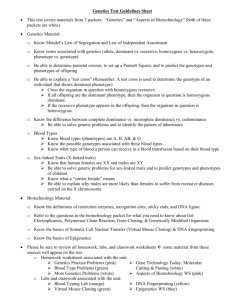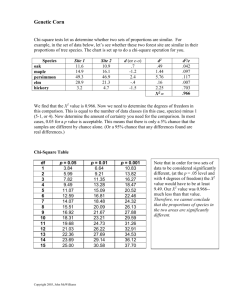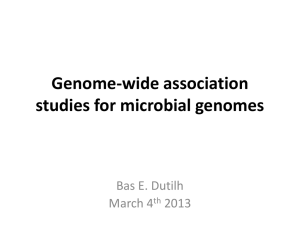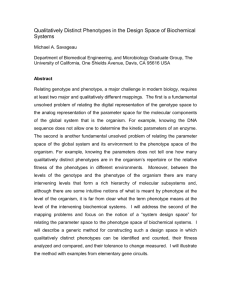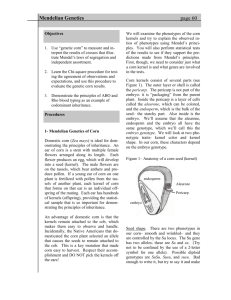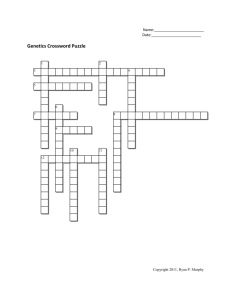Genetics of Corn Kit - Carolina Curriculum
advertisement
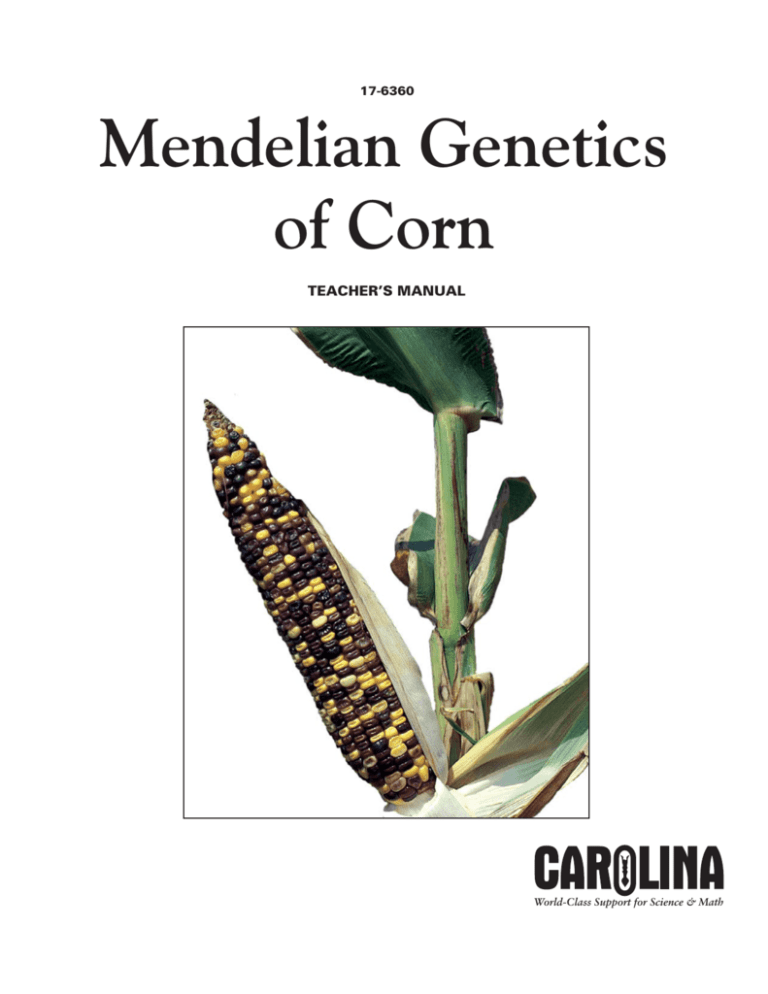
17-6360 Mendelian Genetics of Corn TEACHER’S MANUAL World-Class Support for Science & Math CONTENTS Mendelian Genetics of Corn Overview Storing Your Kit Objectives Required Knowledge Expectations Time Requirements Preparation Student Materials and Equipment Troubleshooting Background Answers to Questions in the Student Guide Further Activities . . . . . . . . . . . . . . . . . . . . . . . . . . . . . . . . . . . . . . . . . . . . . . . . . . . . . . . . . . . . . . . . . . . . . . . . . 3 . . . . . . . . . . . . . . . . . . . . . . . . . . . . . . . . . . . . . . . . . . . . . . . . . . . . . . . . . . . . . . . . . 3 . . . . . . . . . . . . . . . . . . . . . . . . . . . . . . . . . . . . . . . . . . . . . . . . . . . . . . . . . . . . . . . . . . . . . . . . 3 . . . . . . . . . . . . . . . . . . . . . . . . . . . . . . . . . . . . . . . . . . . . . . . . . . . . . . . . . . . . 3 . . . . . . . . . . . . . . . . . . . . . . . . . . . . . . . . . . . . . . . . . . . . . . . . . . . . . . . . . . . . . . . . . . . . . 3 . . . . . . . . . . . . . . . . . . . . . . . . . . . . . . . . . . . . . . . . . . . . . . . . . . . . . . . . . . . . . 4 . . . . . . . . . . . . . . . . . . . . . . . . . . . . . . . . . . . . . . . . . . . . . . . . . . . . . . . . . . . . . . . . . . . . . . 4 . . . . . . . . . . . . . . . . . . . . . . . . . . . . . . . . . . . . . . . . . . . . . . 4 . . . . . . . . . . . . . . . . . . . . . . . . . . . . . . . . . . . . . . . . . . . . . . . . . . . . . . . . . . . . . . . . . 5 . . . . . . . . . . . . . . . . . . . . . . . . . . . . . . . . . . . . . . . . . . . . . . . . . . . . . . . . . . . . . . . . . . . . . . 5 . . . . . . . . . . . . . . . . . . . . . . . . . . . . . . . . . . 7 . . . . . . . . . . . . . . . . . . . . . . . . . . . . . . . . . . . . . . . . . . . . . . . . . . . . . . . . . . . . . . . . 9 Photocopy Masters Student Guide . . . . . . . . . . . . . . . . . . . . . . . . . . . . . . . . . . . . . . . . . . . . . . . . . . . . . . . . . . . . . . . . . ©2004 Carolina Biological Supply Company Printed in USA S-1 Mendelian Genetics of Corn Overview This kit is has been designed for use as an introductory college-level genetics lab or, alternatively, as a high school honors, college-preparatory, or AP® Biology lab. If you are using this kit with less experienced biology students, then you may need to make some modifications. In particular, you may need to help students with Exercise C, modify or eliminate some questions, and assist with or provide Chi-square calculations. If you are using this kit as an alternative to AP® Biology Lab 7: Genetics of Organisms, the activities in this kit meet the objectives of that lab, with the exception of sex-linked inheritance, which must be covered separately. Storing Your Kit With reasonable care, this kit will last for many years. At the other extreme, the kit could be destroyed upon its first use. When not in use, store the ears of corn in the storage box, in a dark area, with the lid sealed. Although the ears have been fumigated, we recommend the use of an insect repellant substance in the box. Some students may “pick” grains off the ears. This should be discouraged before it happens. The loss of a few grains is to be expected. In many cases, it is possible to glue lost grains back into their original positions. Objectives In this laboratory, students will • use corn to study genetic crosses • recognize contrasting phenotypes • collect data from F2 ears of corn, and analyze the results from monohybrid and dihybrid crosses • study dominance, segregation, and independent assortment of alleles in corn • compare predicted results with results obtained from actual data Required Knowledge Before beginning this laboratory, students should understand • meiosis • the chromosomal theory of heredity • the basics of Mendelian Genetics • the use of Punnett Squares • Chi-square analysis of data • the life cycle of organisms useful in genetics studies Expectations At the completion of this laboratory, students should be able to • collect and organize data from genetic crosses Teacher’s Manual 3 Mendelian Genetics of Corn • analyze the data using Chi-square analysis techniques • predict patterns of inheritance given relevant data Time Requirements Exercise A (P1 and F1) and Exercise B (F1 Cross and F2) can be completed in one 45-minute period, although students may have to analyze their data and answer questions outside of class. Alternatively, Exercise A can be completed during 15–20 minutes of one class period and Exercise B can be completed in one 45-minute period. You can require that all grains on each ear be scored or you can assign an arbitrary minimum for each pair of students to score. The class total for all phenotypes counted in Table 1 should be at least 1,000 for each of the crosses. More is better. Comparisons of group totals to class totals can demonstrate the importance of sample size. Exercise C (A Different Cross) can be completed in one 45-minute period. The class total for all phenotypes counted in Table 2 should be at least 2,000. Again, more is certainly better. It is probably best to require that all grains on each ear be scored. Members of a team can alternate scoring the grains, as this will make it less of a chore. Preparation Photocopy the Student Guide from this manual for your class. Student Self-Assessments In the Background section, before beginning Exercise A, students are asked to compile a list of the things they know about Mendelian genetics. This can be done outside of class. We recommend that you collect these lists and examine them closely. They will give you some idea of your students’ background knowledge and level of ability. More importantly, these lists can reveal misconceptions in student knowledge that need to be addressed. Photocopy the lists before returning them to your students. Compare the initial selfassessments to the amended lists that students submit at the end of the laboratory exercise. This will help in assessing student progress. Student Materials and Equipment Following is a list of the materials needed for one group of four students to perform the exercises in this lab. Prepare as many setups as needed for your class. Setup for Each Group Exercise Exercise A B Corn Parental Cross Card A 1 optional 1 Corn Parental Cross Card B Corn Ear: F2 Purple Yellow 1 optional 1 1 Corn Ear: F2 Starchy Sweet 1 Corn Ear: F2 Purple Yellow, Starchy Sweet Transparency Marker 4 Teacher’s Manual Exercise C 1 1 1 Mendelian Genetics of Corn Troubleshooting Before beginning the laboratory exercises, the class as a whole should agree upon the names and genetic symbols they will use during this exercise to describe the phenotypes they observe. Otherwise, student groups will encounter difficulty sharing and assessing data. Background Corn Life Cycle The tassel at the top of the corn plant produces pollen. Pollen grains containing three haploid (n) nuclei are produced from microspores in the stamens of the tassel. One nucleus in each pollen grain becomes the pollen tube nucleus, while the other two become sperm nuclei. The developing ears have rows of pistils that grow long, thin styles (silks) that grow out the ends of the husks that cover the ears. Within each pistil a megaspore gives rise to an embryo sac containing eight haploid nuclei. Two of the megaspore nuclei fuse to form the fusion nucleus (2n) and one becomes the egg nucleus (n). The other five nuclei become separated by cell walls and take no known part in the plant life cycle after the formation of the fusion nucleus and egg nucleus. When a pollen grain falls on the silk, a pollen tube grows from the pollen grain through the silk to the embryo sac. One of the sperm nuclei (n) unites with the fusion nucleus (2n), forming the endosperm nucleus (3n). The other sperm nucleus (n) unites with the egg nucleus (n) to form a zygote (2n). The zygote develops into an embryo that becomes dormant during the seed stage of the corn life cycle. The endosperm nucleus develops into a mass of tissue (the endosperm), which surrounds the embryo. The outer layer of cells of the endosperm is called the aleurone. A corn “seed” is a fruit that consists of the embryo (2n), the endosperm (3n), and endosperm aleurone (3n), all enclosed in a pericarp (2n). The pericarp is a remnant of the pistil and is of maternal origin and genetics. Genetics of Corn In this lab, your students will investigate the inheritance of aleurone and endosperm phenotypes, which involves triploid genetics. However, in these exercises, we treat the maternal pair of genes as a single allele. We do not feel that we have done too much injustice to the true situation, because the maternal pair of alleles are duplicates (R/R or r/r, etc.) of the same allele. The phenotypes studied in these activities involve the presence or absence of color in the aleurone and the composition of the endosperm. The phenotypes are obvious and easy to score by beginners. The color of a corn grain is controlled by a large number of genes that determine the phenotypes of three tissues: the pericarp, the aleurone, and the endosperm proper (see Figure 1). In the corn your students will use, the pericarp is always colorless, but the aleurone may be colorless or purple. Teacher’s Manual 5 Mendelian Genetics of Corn Pericarp Aleurone Endosperm Figure 1: The layers of a corn kernel involved in producing color phenotypes. Although several genes interact in producing aleurone color, it is the R alleles that undergo segregation and recombination in the ears that your students study. Conditions R/R and R/r give a purple aleurone. The homozygous recessive (r/r) disrupts anthocyanin production and results in a colorless aleurone. If the aleurone is colorless, the corn color will be that of the endosperm, which in this case is yellow due to the presence of carotenoid pigments. (The parent corn stocks for all the crosses used in this kit are Y/Y for endosperm carotenoids.) Normal corn endosperm is high in amylose starch. The gene Su in the homozygous recessive condition (su/su) produces endosperm that is high in sugar. As the corn dries, the sugary endosperm loses water and the seeds wrinkle. The Crosses Students begin by studying either of two monohybrid crosses: a cross of purple starchy (R/R Su/Su) with yellow starchy (r/r Su/Su) or a cross of yellow starchy (r/r Su/Su) with yellow sweet (r/r su/su). More specifically, it is the R2 alleles located on Chromosome 2 and the Su1 alleles located on Chromosome 4 that are used in these crosses. In the purple starchy with yellow starchy (purple:yellow) cross, only the R color alleles undergo segregation and recombination, so we show only those alleles, while remembering that the alleles for starchy are present. P1 R/R ¥ r/r F1 heterozygous Purple R/r F1 cross R/r ¥ R/r F2 R/R R/r r/r phenotypes Purple, Yellow in a phenotype ratio of 3:1 In the yellow starchy with yellow sweet (starchy:sweet) cross, only the Su alleles are segregating and recombining. P1 Su/Su ¥ su/su F1 heterozygous Starchy Su/su F1 cross Su/su ¥ Su/su F2 Su/Su Su/su su/su phenotypes Starchy, Sweet in a phenotype ratio of 3:1 6 Teacher’s Manual Mendelian Genetics of Corn In the dihybrid cross, both sets of alleles are segregating and recombining. P1 R/R Su/Su ¥ r/r su/su F1 heterozygous Purple heterozygous Starchy R/r Su/su F1 cross R/r Su/su ¥ R/r Su/su F2 phenotypes Purple Starchy, Purple Sweet, Yellow Starchy, Yellow Sweet in a 9:3:3:1 ratio Transposable Elements In the 1940s, while studying the inheritance of speckled (as opposed to solid) color in corn grains, Barbara McClintock found that she could not map the locus of the responsible gene, because it moved about on the chromosome. These transposable elements, as they are now called, are common in corn and other organisms. In corn, they can disrupt color production in the aleurone so that most of the grain is yellow with only specks or restricted areas of purple. Our breeding program seeks to eliminate the effects of transposable elements on grain color, but examine your corn carefully. Any grain that clearly has at least one speck of purple color should be scored as having the purple phenotype, because it has at least one copy of the R allele. Answers to Questions in the Student Guide Exercise B: F1 Cross and F2 1. What evidence do you have that the phenotypes you are investigating are actually being inherited? Could they simply be the result of environmental effects? If the phenotypes were the result of environmental effects, all phenotypes should have been the same, or the phenotypes should be distributed randomly in the offspring. 2. If the phenotypes are under genetic control, are they inherited through a single gene, a few genes, or many genes? How do you know? The phenotypes are inherited through a single gene. If several genes were involved, there would not be a 3:1 phenotype ratio in the F2. There would be much more variation in the offspring. 3. State, as completely as you can, your hypothesis about the inheritance of the phenotypes. Each phenotype is inherited as an allele through a single gene locus. The allele for yellow (or sweet) is recessive to the allele for purple (or starchy). 4. Using the class’s data from Table 1 and information from your Punnett Square, calculate the expected counts for the F2 and record them below. Answers will vary according to data collected. 5. Compare the class’s actual counts to your calculated expected counts. Do the actual counts deviate from what was expected? If so, explain why. Yes. The actual results are determined by chance; therefore, some variation from expected (ideal) results is to be expected. Teacher’s Manual 7 Mendelian Genetics of Corn 6. Are the deviations from the expected results for the phenotypic ratio of the F2 generation within the limits expected by chance? To answer this question, statistically analyze the data using Chi-square analysis. Refer to the Chi-Square (c2) Test section on page S–9. In the space below, calculate the Chi-square statistic for the F2 generation. Refer to Table 3 on page S–9 to determine the probability that is associated with your c2 statistic. Answers should be based on Chi-square data. The answers will vary according to specific data collected, but deviations should be within limits expected by chance. There are web sites that will calculate c2 values for input data. You may prefer that students perform an Internet search and use one of these sites. There are also computer programs that will do the same thing. Following the calculation of c2 values, lead a class discussion of sources of error in the data. This is especially valuable if the c2 value indicates that the data does not support the expected ratio. Mistakes in scoring the phenotypes are the most common source of error. 7. What does this probability mean? Specific answers will vary with data, but should recognize that the data is compatible with the null hypothesis. Note that acceptance of the null hypothesis is provisional. The null hypothesis can never be proven, only supported more-orless strongly by the data. Exercise C: A Different Cross 1. On the basis of the data recorded in Table 2, what new inference can you make about the inheritance of the phenotypes? The alleles R and Su are not linked. If they were linked, the phenotype ratio in the F2 would be close to 3:1, with some recombination due to crossing over. 2. Calculate the expected counts for the F2 and record them below. Answers will vary with data. 3. Calculate the Chi-square statistic for this new data set. What does the value tell you about the class’s data? Specific answers will vary with data, but should recognize that the data is compatible with the null hypothesis. Chi-Square (c2) Test List at least three possible sources of error that could explain why the data in this example does not fit the expected 3:1 ratio. • The sample size was too small. • The phenotypes were scored incorrectly. • Some of the crosses were contaminated. (Some of the crosses were incorrectly made.) 8 Teacher’s Manual Mendelian Further Activities Genetics of Corn 1. Students who do not relate the events in meiosis and fertilization to the segregation and recombination of alleles can have difficulty understanding genetics. These students may benefit from making posters of meiosis showing chromosomes with the alleles they are studying attached. This visualization may help them understand what can otherwise seem to be a confusing set of rules. 2. Mendelian genetics involves chance events. Because some students equate chance with chaos, they can have trouble understanding how chance can ever produce an orderly sequence. These students can benefit from some simple probability studies. For example, let the head of a penny represent a dominant allele for a trait and the tail represent the corresponding recessive allele. Students could use purple and yellow as the phenotypes, or anything else. Pairs of students flip two pennies to represent the crossing of F1 hybrids. The results (H/H, H/h, or h/h) give the genotype of the F2. Each pair of students can flip their coins 100 times, then determine a class total. This activity can help students to better understand the role of probability in genetics. For a more elaborate study, nickels and pennies can be used to simulate a heterozygous dihybrid cross. 3. Use coin flipping to teach the concept of c2. Ask students, “If you flipped a coin 10 times, how many heads and tails should you get?” Students know they should get 5 of each result. They also know that they may not. Have every student in the class flip a coin 10 times, record the results, and share them with the class. Ask them why (presumably) some class members got results different from the theoretical results. Students may conclude that actual results differ from theoretical results merely by chance. Next, pose this problem to the class: “Suppose that you did not know that there is an equal probability of getting heads and tails. How could you decide whether the results you got represent random deviations from 50:50 or not?” Students may suggest good ideas such as repeating the test many times. Have students conduct a c2 analysis of their coin-flipping results. This will help them learn how to calculate expected results, the value of c2, determine the degrees of freedom, and so on. 4. The biochemical pathways through which alleles R and Su are expressed are known in some detail. Students can research this on the Internet. This offers an opportunity to connect Mendelian genetics with AP® Lab 6: Molecular Biology. Teacher’s Manual 9 Mendelian 10 T e a c h e r ’ s M a n u a l Genetics of Corn Student Guide Name 17-6360 Date Mendelian Genetics of Corn Objectives In this laboratory, you will • use corn to study genetic crosses • recognize contrasting phenotypes • collect data from F2 ears of corn, and analyze the results from monohybrid and dihybrid crosses • study dominance, segregation, and independent assortment of alleles in corn • compare predicted results with results obtained from actual data Required Knowledge Before beginning this laboratory, you should understand • meiosis • the chromosomal theory of heredity • the basics of Mendelian Genetics • the use of Punnett Squares • Chi-square analysis of data • the life cycle of organisms useful in genetics studies Expectations At the completion of this laboratory, you should be able to • collect and organize data from genetic crosses • analyze the data using Chi-square analysis techniques • predict patterns of inheritance given relevant data Introduction Zea maize, commonly called corn in the United States, is one of the world’s most important food crops. Because of its economic importance, the genetics of corn has been studied extensively. In sexual reproduction, two gametes fuse, bringing together homologous chromosomes from both parents. Corn has 10 pairs of chromosomes. These chromosomes are numbered 1, 2, 3, etc. One member of the pair is inherited from the “male” parent and the other is inherited from the “female” parent. For example, on Chromosome 2, there is a gene for plant height, and there are two forms or alleles of this gene, D5, a dominant allele for normal height, and d5, a recessive allele for dwarf height. If both alleles on Chromosome pair 2 are for normal height (D5/D5), the phenotype (appearance or form observed) is normal height and the genotype is homozygous normal height. If the two alleles are different (D5/d5), the phenotype is normal height and the genotype is heterozygous normal height. If the two alleles are for dwarf height (d5/d5), the phenotype is dwarf height and the genotype is homozygous dwarf height or simply homozygous recessive. ©2004 Carolina Biological Supply Company S-1 Given this information, we can now diagram and predict the results of crossing a homozygous normal height corn with a homozygous dwarf variety of corn. P1 D5/D5 ¥ d5/d5 Gametes D5 d5 F1 D5/d5 P1 designates the parents of this cross and F1 (first filial, a word that refers to siblings) designates their offspring. All of the gametes produced by one parent carry the dominant allele and all of the gametes produced by the other carry the recessive allele1, so there is only one possible combination of alleles for the F1: all have the phenotype normal height and the genotype heterozygous normal height. If the F1 are crossed, we obtain different results. F1 cross D5/d5 ¥ D5/d5 Gametes D5 d5 D5 d 5 We can use a Punnett Square to determine how the gametes will recombine in the next, or F2, generation. d5 Gametes D5 D5 D5/D5 D5/d5 d5 D5/d5 d5/d5 Thus, in the F2, there are four possible combinations of gametes: 1 for homozygous normal height (phenotype normal height) 2 for heterozygous normal height (phenotype normal height) 1 for homozygous dwarf height (phenotype dwarf height) This gives an expected phenotype ratio in the F2 of 3 normal-height plants to 1 dwarf-height plant. Determining Expected Counts With this information, we can calculate the expected numbers of each phenotype. Suppose we perform the cross and harvest 1000 F2 corn grains. How many of these grains should we expect to germinate into plants of normal height? How many dwarf plants should we expect? The expected ratio is 3:1. Since the total of 3 + 1 is 4, we first determine 1/4 of the whole (1000 ∏ 4 = 250). The expected count for 1000 grains is calculated as 3(250):1(250) or 750 normal height to 250 dwarf plants in the F2. Background In these activities, you will investigate several phenotypes of corn that are expressed in the seed. You will be given ears of corn for your investigation. Each seed on an ear results from a separate fertilization event. Further, the seeds on the ear are the F2 from a cross that began with two parental varieties of corn with contrasting phenotypes. 1 For this discussion, we ignore mutation and other possible, though unlikely, events. ©2004 Carolina Biological Supply Company S-2 To successfully complete these activities, you must have good background knowledge of genetics. On a sheet of notebook paper, list the things you know about genetics that you think will help you complete these activities. Include at least six different facts that you know about genetics and explain how this knowledge will help you. Here are some questions to help you get started, but don’t be limited by these questions. Keep the paper as a reference during the rest of this lab. Add to or modify your Background Knowledge notes as needed. 1. How will I know which allele is dominant and which allele is recessive? 2. Am I dealing with a monohybrid or a dihybrid cross? How will this affect my results? 3. How will I know what the F2 seed should look like? What phenotype ratio will I expect in the F2? 4. How will I know that my results are valid? Exercise A: P1 and F1 Your group will be given two Corn Parental Cross Cards, A and B, that show a cross of two parental varieties of corn with contrasting phenotypes as well as the F1 corn resulting from the cross. Two of you will work with the cross shown on card A and two will work with the cross shown on card B. All the P1 corn varieties are homozygous for all the genotypes you will be studying. Examine the cross that is shown on your Corn Parental Cross Card. Collect information and complete steps 1–5 below. 1. Will you treat this as a monohybrid cross or a dihybrid cross? Explain your answer. ________________________________________________________________________ ________________________________________________________________________ ________________________________________________________________________ ________________________________________________________________________ 2. Decide on a one-word description of the phenotype of each of your P1 corn varieties. Record the descriptions in the blanks below. Phenotype of (choose one) A-1 or B-1 _________________________________________ Phenotype of (choose one) A-2 or B-2 _________________________________________ 3. Decide what symbols you will use to represent the alleles by which these phenotypes are inherited. Record the symbols in the blanks below. ________ is the symbol for the allele ____________________________________ ________ is the symbol for the allele ____________________________________ 4. Which allele is dominant? Explain how you know. ________________________________________________________________________ ________________________________________________________________________ ________________________________________________________________________ ________________________________________________________________________ 5. What is the genotype of the F1? ______________________________________________ ©2004 Carolina Biological Supply Company S-3 Exercise B: F1 Cross and F2 Using the information you recorded in Exercise A and your knowledge of genetics, draw in the space below a Punnett Square showing the results of crossing your F1 to obtain an F2. Below the Punnett Square, give the phenotypes and their expected ratios for the F2. Phenotypes and expected ratios for the F2: ___________________________________________ ______________________________________________________________________________ Your teacher will now give you an F2 ear of corn from the cross you diagramed above. Working in pairs, count and record in Table 1 (below) the number of grains of each phenotype. One person should call out the phenotypes while the other records them in the table. To make the count, mark the beginning of one row of grains and count and record the phenotypes of each grain in that row. Continue counting, marking the beginning of each row as you count. When finished counting, total your results. Then obtain and record the class totals for the same cross. Table 1: F2 Phenotype Count for _____________________ ¥ _____________________ Phenotype Team Count Total: Total: Team total for all phenotypes counted: Class Count Total: Total: Class total for all phenotypes counted: ©2004 Carolina Biological Supply Company S-4 Questions 1. What evidence do you have that the phenotypes you are investigating are actually being inherited? Could they simply be the result of environmental effects? ______________________________________________________________________________ ______________________________________________________________________________ ______________________________________________________________________________ ______________________________________________________________________________ ______________________________________________________________________________ 2. If the phenotypes are under genetic control, are they inherited through a single gene, a few genes, or many genes? How do you know? ______________________________________________________________________________ ______________________________________________________________________________ ______________________________________________________________________________ ______________________________________________________________________________ 3. State, as completely as you can, your hypothesis about the inheritance of the phenotypes. ______________________________________________________________________________ ______________________________________________________________________________ ______________________________________________________________________________ ______________________________________________________________________________ ______________________________________________________________________________ 4. Using the class’s data from Table 1 and information from your Punnett Square, calculate the expected counts for the F2 and record them below. Phenotype __________________ Expected count ______________ Phenotype __________________ Expected count ______________ 5. Compare the class’s actual counts to your calculated expected counts. Do the actual counts deviate from what was expected? If so, explain why. ________________________________________________________________________ ________________________________________________________________________ ________________________________________________________________________ ________________________________________________________________________ ©2004 Carolina Biological Supply Company S-5 6. Are the deviations from the expected results for the phenotypic ratio of the F2 generation within the limits expected by chance? To answer this question, statistically analyze the data using Chi-square analysis. Refer to the Chi-Square (c2) Test section on page S–9. In the space below, calculate the Chi-square statistic for the F2 generation. Refer to Table 3 on page S–9 to determine the probability that is associated with your c2 statistic. _________ = c2 _________ = % probability that the observed variation is due to random chance alone 7. What does this probability mean? ________________________________________________________________________ ________________________________________________________________________ ________________________________________________________________________ ________________________________________________________________________ Exercise C: A Different Cross As a team, look again at the Corn Parental Cross Cards, A and B. Remember that all of the P1 seeds are homozygous for all of the genotypes that you are studying. This means that the P1 shown on Card A are homozygous for the alleles involved in the cross shown on Card B, and the P1 shown on Card B are homozygous for the alleles involved in the cross shown on Card A. Suppose you performed a new cross using, as your P1, corn varieties A-1 and B-1. Working as a team, collect the following information about this cross as you complete the steps below. 1. Will you treat this as a monohybrid cross or a dihybrid cross? Explain your answer. ________________________________________________________________________ ________________________________________________________________________ ________________________________________________________________________ ________________________________________________________________________ ©2004 Carolina Biological Supply Company S-6 2. Give the genotypes and phenotypes for the P1 and F1 of this cross. A-1 P1 B-1 ¥ Genotype _____________ Phenotype ___________________ Genotype _____________ Phenotype ___________________ F1 Genotype _____________ Phenotype ___________________ 3. In the space below, construct a Punnett Square showing the results of crossing your F1 to obtain an F2. Below the Punnett Square, give the phenotypes and their expected ratios for the F2 of this cross. Phenotypes and expected ratios for the F2: ________________________________________ ___________________________________________________________________________ ___________________________________________________________________________ ©2004 Carolina Biological Supply Company S-7 Your teacher will now give you an F2 ear of this cross. Count and record phenotypes in Table 2 below. Also, record count totals for the class. Table 2: F2 Phenotype Count for _____________________ ¥ _____________________ Phenotype Team Count Total: Class Count Total: Total: Total: Team total for all phenotypes counted: Total: Total: Total: Total: Class total for all phenotypes counted: Questions 1. On the basis of the data recorded in Table 2, what new inference can you make about the inheritance of the phenotypes? ______________________________________________________________________________ ______________________________________________________________________________ ______________________________________________________________________________ ______________________________________________________________________________ ______________________________________________________________________________ 2. Calculate the expected counts for the F2 and record them below. Phenotype _____________________________ Expected count _________ Phenotype _____________________________ Expected count _________ Phenotype _____________________________ Expected count _________ Phenotype _____________________________ Expected count _________ 3. Calculate the Chi-square statistic for this new data set. What does the value tell you about the class’s data? ______________________________________________________________________________ ______________________________________________________________________________ ______________________________________________________________________________ ______________________________________________________________________________ ©2004 Carolina Biological Supply Company S-8 Final Activity Refer to the Background Knowledge notes that you produced at the beginning of this lab. Make any needed additions, corrections, or deletions that you feel are necessary. Explain the ways in which your knowledge of genetics changed as a result of performing this lab. Chi-Square (c2) Test Does your data, as recorded in the activities above, actually support your hypothesis about how the trait is inherited? Genetics, like gambling, deals with probabilities. When you flip a coin, you have the same chance of getting a head as a tail: a one-to-one ratio. That does not mean that if you flip a coin 100 times you will always get 50 heads and 50 tails. You might get 53 heads and 47 tails. That is probably close enough to a one-to-one ratio that we would accept it without a second thought. But what if you got 61 heads and 39 tails? At what point do you begin to suspect that something other than chance is at work in determining the fall of your coin? Look back at your data. You were expecting a 3:1 or 9:3:3:1 phenotype ratio in the F2. This assumes that chance (and chance only) has been operating in the assortment and recombination of alleles that gave rise to the F1 and F2 you have investigated. Thus, any variation of the observed results from the expected results are due to chance. This is known as the null hypothesis. Does your data actually support the null hypothesis? The Chi-square (c2) test is a statistical test used to determine how well observed ratios fit expected ratios. The difference between the number observed and the number expected for a phenotype is squared and then divided by the number expected. This is repeated for each phenotype class. The c2 value consists of the summation of these values for all classes. The formula for c2 is: c2 = total of (observed – expected)2 for all cases expected The calculated value for c2 is then compared to the values given in a statistical table, such as the one shown here. Table 3: Chi-Square Values and Probabilities (5% or Less is Considered Significant) Degrees of Freedom 1 2 3 4 5 6 7 8 9 10 p = 99% 0.000157 0.020 0.115 0.297 0.554 0.872 1.239 1.646 2.088 2.558 95% 0.00393 0.103 0.352 0.711 1.145 1.635 2.167 2.733 3.325 3.940 80% 0.0642 0.446 1.005 1.649 2.343 3.070 3.822 4.594 5.380 6.179 50% 0.455 1.386 2.366 3.357 4.351 5.348 6.346 7.344 8.343 9.342 20% 1.642 3.219 4.642 5.989 7.289 8.558 9.803 11.030 12.242 13.442 5% 3.841 5.991 7.815 9.488 11.070 12.592 14.067 15.507 16.919 18.307 1% 6.635 9.210 11.345 13.277 15.086 16.812 18.475 20.090 21.666 23.209 In this table, note the column titled, “Degrees of Freedom.” The degree of freedom is always one less than the number of different phenotypes possible. For the monohybrid F2 in this experiment we have two possible phenotypes so there are 2 – 1 = 1 degree of freedom. For a dihybrid F2, there are four possible phenotype combinations and 3 degrees of freedom. The numbers to the right of the Degrees of Freedom column in the table are c2 values. The percentages given at the top of each column represent the probability that the variation of the observed results from the expected results is due to chance. If the probability value is greater than 5%, we accept the null hypothesis; that is, our data fits the expected ratios. Following are two examples, one for a monohybrid cross and one for a dihybrid cross. ©2004 Carolina Biological Supply Company S-9 In an F2 population of 100 Drosophila (fruit flies), there are 60 with normal wings and 40 with vestigial wings (expected ratio would be 75 normal wings:25 vestigial wings). Therefore: c2 = (60 – 75)2 + (40 – 25 )2 = 3 + 9 = 12.0 75 25 Looking at the table, in the row for 1 degree of freedom, for c2 = 12, the probability is less than 1%. Therefore, these results do not support the expectation (or null hypothesis) of a 3:1 ratio, since the probability is significant (less than 5%) that deviation from the expected ratio is due to chance. List at least three possible sources of error that could explain why the data in this example does not fit the expected 3:1 ratio. 1. ______________________________________________________________________________ ______________________________________________________________________________ 2. ______________________________________________________________________________ ______________________________________________________________________________ 3. ______________________________________________________________________________ ______________________________________________________________________________ Now consider the following data for F2 Drosophila of a dihybrid cross of P1 flies having normal wings and red eyes with flies having vestigial wings and sepia eyes. The alleles for normal wings and red eyes are dominant. The expected phenotype ratio is 9 Normal wings, Red eyes:3 Normal wings, Sepia eyes:3 Vestigial wings, Red eyes:1 Vestigial wings, Sepia eyes. 1 2 3 4 Normal wIngs, Normal wings, Vestigial wings Vestigal wings Red eyes Sepia eyes Red eyes Sepia eyes Phenotype Phenotype Count Expected Numbers Total 4 577 204 176 59 1016 571.5 190.5 190.5 63.5 1016 c2 = (577 – 571.5)2 + (204 – 190.5)2 + (176 – 190.5)2 + (59 – 63.5)2 = 2.43 571.5 190.5 190.5 63.5 The probability of 2.43 from the table for three degrees of freedom is greater than 30% but less than 50%. This means that a deviation as large or larger would be expected to occur purely by chance more than 30 percent (but less than 50%) of the time. Such a deviation is not significant (because the probability is greater than 5%), so we accept the null hypothesis in favor of the 9:3:3:1 ratio. Note that this acceptance is provisional. Additional data could always cause us to reject the null hypothesis. ©2004 Carolina Biological Supply Company S-10 Carolina Biological Supply Company 2700 York Road, Burlington, North Carolina 27215 Phone: 800.334.5551 • Fax: 800.222.7112 Technical Support: 800.227.1150 • www.carolina.com CB211880407

